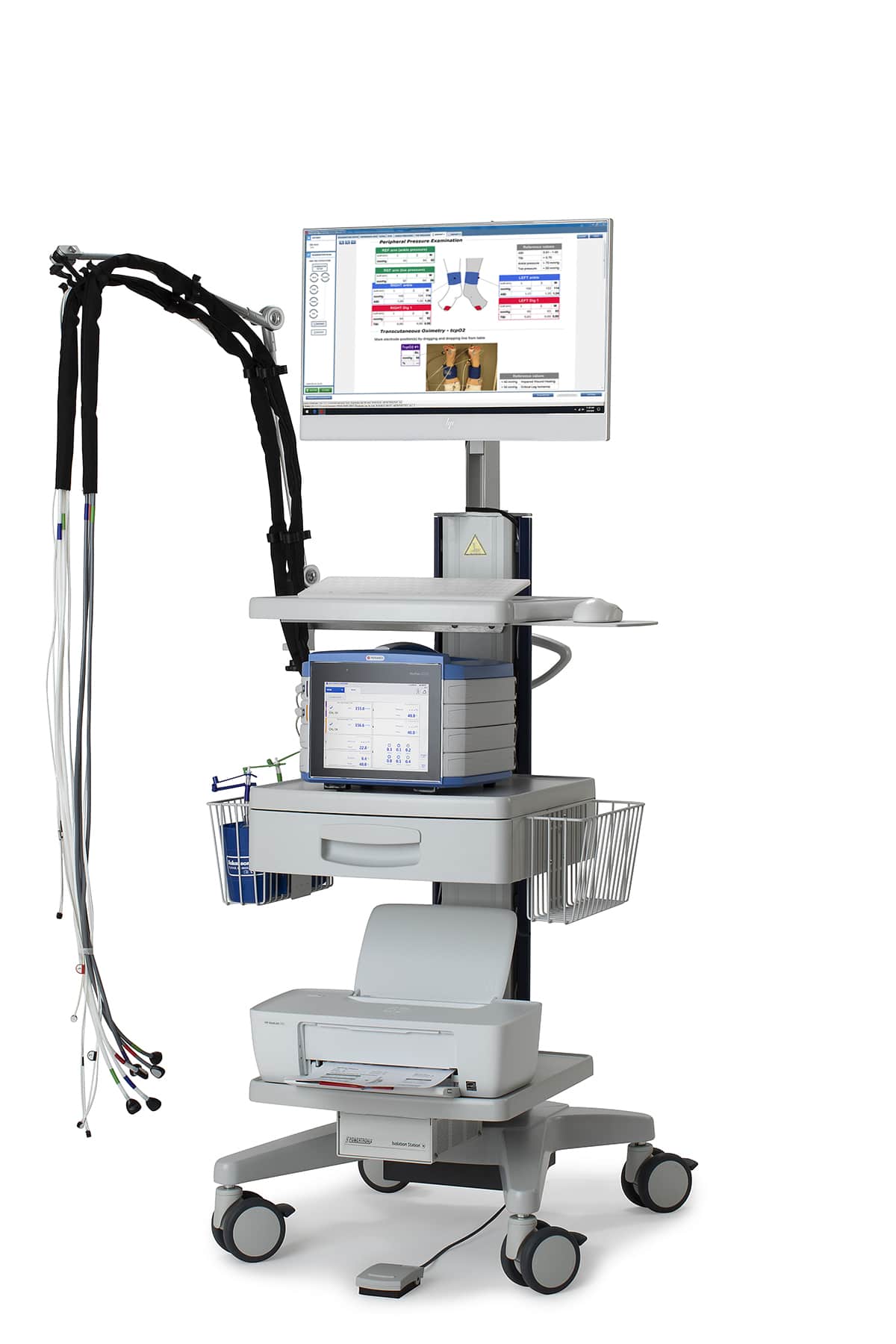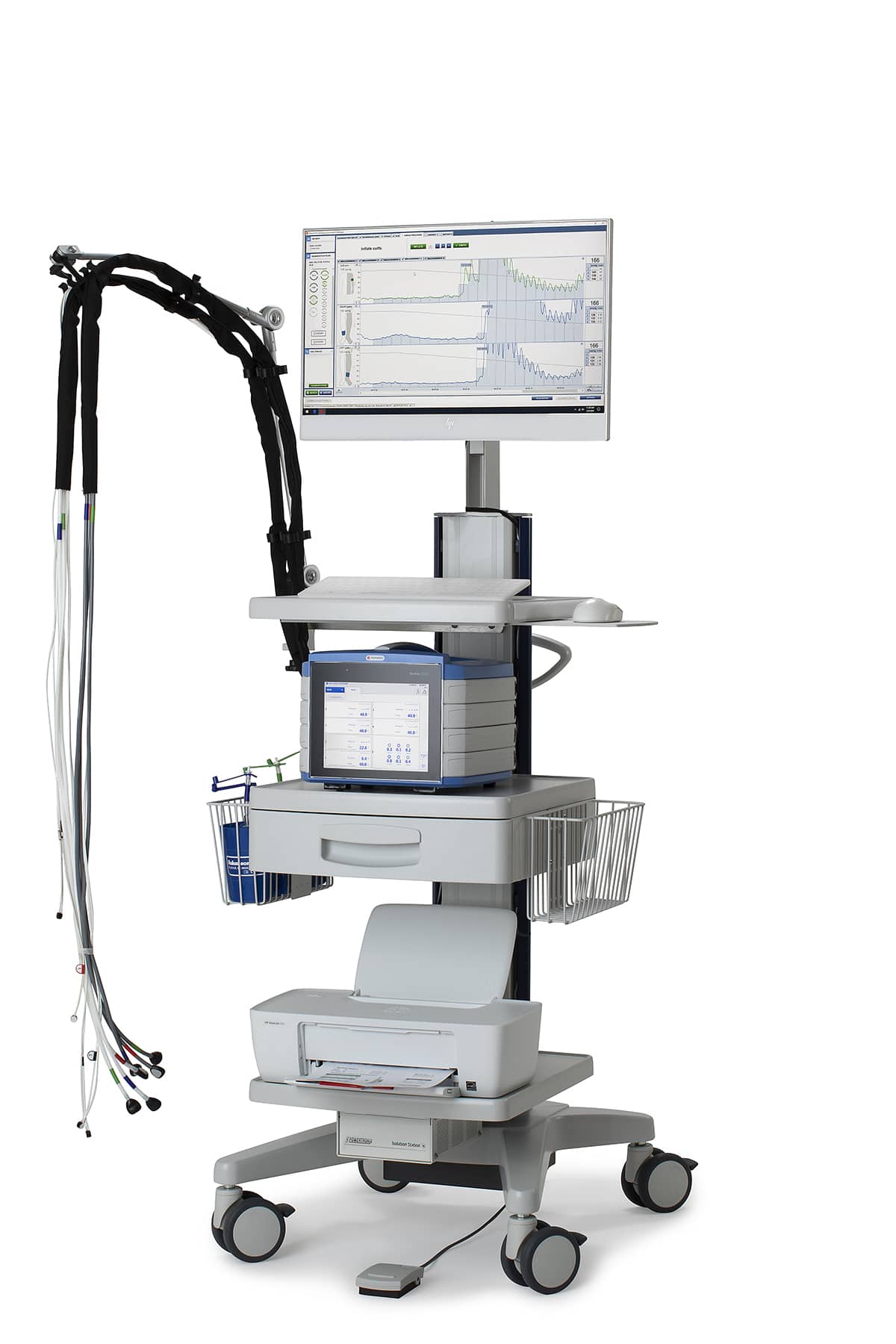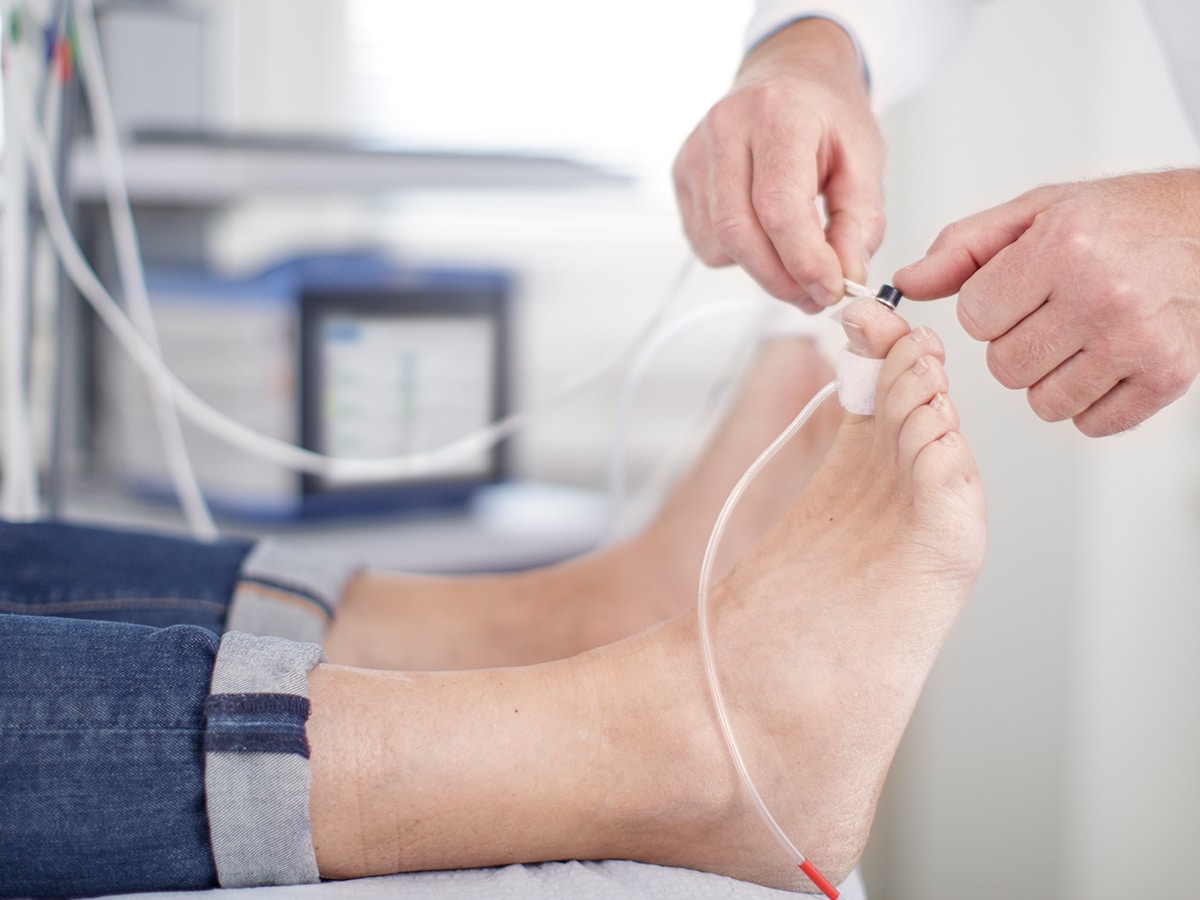Ankle Pressure (ABI)
— for accurate PAD diagnosis
![]()
Toe/Ankle Pressure (TBI/ABI) have proven to be an accurate option for the diagnosis of PAD in patients at risk for falsely elevated ankle-brachial index (ABI) values, as vessels in the toes are usually not affected by calcification. The procedure is similar to an ABI test but requires small cuffs and a sensitive probe.
Perimed equipment uses the highest quality laser Doppler (LD) technique for detection, combined with a unique local heating feature to ensure reliable and reproducible results. This is superior to photoplethysmography (PPG) because LD is better able to detect low pressures1The usefulness of a laser Doppler in the measurement of toe blood pressures. Jurgen C. de Graaff, MD, et al. J Vasc Surg 2000;32:1172-9. Doi: 10.1067/mva.2000.108009.
- Toe pressures are a better option in patients where ABI values are unreliable due to arterial calcification2Mills JL, Conte MS, Armstrong DG, et al. The Society for Vascular Surgery Lower Extremity Threatened Limb Classification System: Risk stratification based on Wound, Ischemia, and foot Infection (WIfI). J Vasc Surg. 2014;59(1):220034.e1-2..
- Occlusions below the level of the ankle can be detected with toe pressure.
- The small vessels in the toes are sensitive to cold ambient temperatures that can lead to vasoconstriction; hence the importance of controlling the temperature of the toes.
- Objective hemodynamic testing, including toe pressures as the preferred measure, is required to assess CLTI3Conte MS, Bradbury AW, Kolh P, et. al, Global Vascular Guidelines on the Management of Chronic Limb-Threatening Ischemia. Eur J Vasc Endovasc Surg. 2019 Jul;58(1S):S1-S109.e33. doi: 10.1016/j.ejvs.2019.05.006..
ABI remains the gold standard for first-line PAD diagnosis in patients without diabetes. There are several different ways to perform an ABI. Ultrasound is the most common method used at vascular labs, while the less accurate oscillometric devices have gained popularity in primary care settings4Measurement and interpretation of the ankle-brachial index: a scientific statement from the American Heart Association. Victor Aboyans, MD, PhD. 2012 Dec 11;126(24):2890-909. doi: 10.1161/CIR.0b013e318276fbcb.. However, only low ABIs should be trusted in patients at risk for calcified vessels (e.g., those with diabetes and chronic kidney disease). Normal values (ABI > 0.9) should always be confirmed with toe pressures. If toes are not available or suitable for measurement, then tcpO2, PVR, and SPP are valid alternatives5Research: Treatment Clinical examination and non-invasive screening tests in the diagnosis of peripheral artery disease in people with diabetes-related foot ulceration. Diabetic Medecine. B. Vriens, F. D’Abate, B. A. Ozdemir , C. Fenner, W. Maynard, J. Budge, D. Carradice and R. J. Hinchliffe. DOI: 10.1111/dme.13634.,3.,6Chapter II: Diagnostic Methods. P.Caoa, H.H.Eckstein, P.De Rango, C.Setacci, J-B.Riccoe, G. Donato, F.Becker, H.Robert-Ebadi, N.Diehm, J.Schmid, M.Teraa, F.L.Moll, F.Dick, A.H.Davies, M.Lepäntalo, J.Apelqvist. doi.org/10.1016/S1078-5884(11)60010-5..
References:
- The usefulness of a laser Doppler in the measurement of toe blood pressures. Jurgen C. de Graaff, MD, et al. J Vasc Surg 2000;32:1172-9. Doi: 10.1067/mva.2000.108009
- Mills JL, Conte MS, Armstrong DG, et al. The Society for Vascular Surgery Lower Extremity Threatened Limb Classification System: Risk stratification based on Wound, Ischemia, and foot Infection (WIfI). J Vasc Surg. 2014;59(1):220034.e1-2.
- Conte MS, Bradbury AW, Kolh P, et. al, Global Vascular Guidelines on the Management of Chronic Limb-Threatening Ischemia. Eur J Vasc Endovasc Surg. 2019 Jul;58(1S):S1-S109.e33. doi: 10.1016/j.ejvs.2019.05.006.
- Measurement and interpretation of the ankle-brachial index: a scientific statement from the American Heart Association. Victor Aboyans, MD, PhD. 2012 Dec 11;126(24):2890-909. doi: 10.1161/CIR.0b013e318276fbcb.
- Research: Treatment Clinical examination and non-invasive screening tests in the diagnosis of peripheral artery disease in people with diabetes-related foot ulceration. Diabetic Medecine. B. Vriens, F. D’Abate, B. A. Ozdemir , C. Fenner, W. Maynard, J. Budge, D. Carradice and R. J. Hinchliffe. DOI: 10.1111/dme.13634.,3.
- Chapter II: Diagnostic Methods. P.Caoa, H.H.Eckstein, P.De Rango, C.Setacci, J-B.Riccoe, G. Donato, F.Becker, H.Robert-Ebadi, N.Diehm, J.Schmid, M.Teraa, F.L.Moll, F.Dick, A.H.Davies, M.Lepäntalo, J.Apelqvist. doi.org/10.1016/S1078-5884(11)60010-5.
Disclaimer: It is possible that the products on the Perimed website may not be cleared for sale in all markets.





